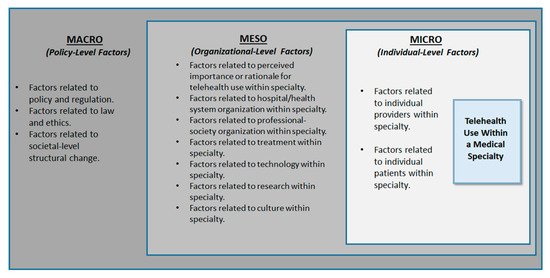Your browser does not fully support modern features. Please upgrade for a smoother experience.
Please note this is an old version of this entry, which may differ significantly from the current revision.
Subjects:
Health Care Sciences & Services
This paper leverages the Macro-Meso-Micro (three-layer) conceptual framework to characterize the factors influencing telehealth use within a medical specialty. Based on this framework, three levels of factors, including, macro (societal or policy-level), meso (group or organizational-level), and micro (individual-level) factors can help to explain behavior, e.g., telehealth use within a medical specialty.
- telehealth use
- telehealth sustainability
- telemedicine policy
- medical specialties
- hospital organizations
- specialty societies
- patient-centered care
- provider culture
Development of the Macro-Meso-Micro Framework on Factors Influencing Telehealth Use within a Medical Specialty
The macro level incorporates policy-level factors, legal-ethical factors, and other societal-level structural factors (e.g., growing healthcare costs and anticipated workforce shortages) influencing telehealth use within a medical specialty. For example, in the US, reimbursement and coverage for telehealth services are not regulated at a national level, which in turn has served as a barrier to telehealth use across nearly all medical specialties. Although Medicare coverage for telehealth has increased during the pandemic, the US continues to lack a standardized set of telehealth reimbursement policies.
At the meso level, emphasis is placed on the role of historical rationale for telehealth use, hospital/health system organizational factors, professional-society factors, technology factors, treatment factors, research factors and cultural factors within a medical specialty. For example, the historical rationale for using telemedicine in allergy-immunology, was to ‘improve access to care’ for underserved populations. In other words, in this specialty, telehealth was not perceived as having the potential to (1) ‘improve patient experience’ (e.g., through patient empowerment for asthma control), (2) ‘reduce healthcare costs; (e.g., by decreasing hospitalizations for asthma), or (3) ‘promote population health’ (e.g., by making self-management of asthma more effective).
At the micro level emphasis is placed on the role of individual provider-level and patient-level factors influencing telehealth use. With respect tp provider-level factors, providers in specialties with higher telehealth use are reported to have made proactive efforts to partner with and engage patients in use of telehealth services. For example, in psychiatry, diverse patient groups have reported that they are comfortable using telepsychiatry.88 In cardiology, remote monitoring has been found to improve confidence of older patients in managing heart failure symptoms.
In summary, a review of the existing literature helped to identify a total of 12 factors influencing telehealth use within a medical specialty across macro-meso-micro levels, including 3 at the macro level, 7 at the meso level and 2 at the micro level. The final conceptual framework is summarized in Figure 1.

Figure 1. Conceptual Framework on Factors Influencing Telehealth Use Within a Medical Specialty.
This entry is adapted from the peer-reviewed paper 10.3390/ijerph18094995
This entry is offline, you can click here to edit this entry!
